Introduction
Lens & Imaging System
{{section_header}}{{section.name}}{{/section_header}}

Like the Sony HDR-TD10, the JVC GS-TD1 has a built-in dual lens and sensor system that produces the camcorder's 3D effect. The dual lens is always part of the camcorder—unlike what you see on Panasonic's 3D capable models—and that means you don't have to calibrate or setup the lens in order to initiate 3D recording. In 3D record mode, the lens only allows for 5x optical zoom, but this is bumped up to 10x zoom when you shoot 2D with the TD1.
Front
{{section_header}}{{section.name}}{{/section_header}}
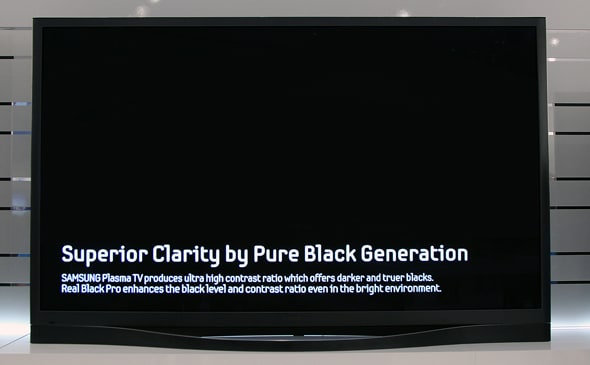
Right
{{section_header}}{{section.name}}{{/section_header}}
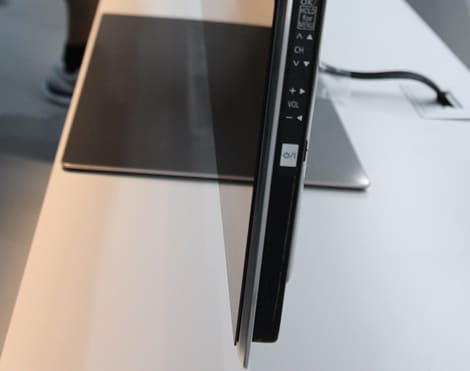
Back
{{section_header}}{{section.name}}{{/section_header}}
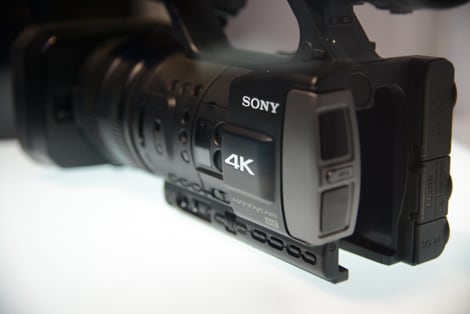
Left
{{section_header}}{{section.name}}{{/section_header}}
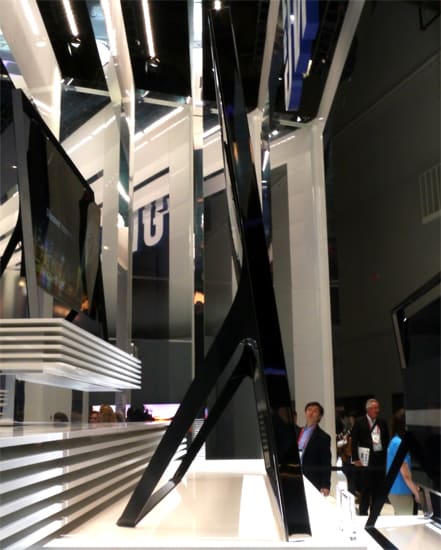
Bottom
{{section_header}}{{section.name}}{{/section_header}}
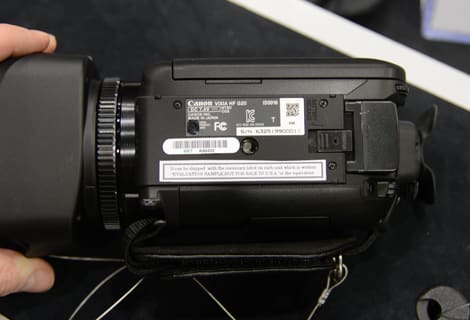
Compression
{{section_header}}{{section.name}}{{/section_header}}
Because of its 3D record mode, the GS-TD1 has a number of compression options. You can shoot 3D video using regular AVCHD compression (called side-by-side 3D), or you can shoot double Full HD video using the camcorder's MVC original compression format. This format is required because AVCHD cannot handle two Full HD images that are needed for JVC's Double Full HD system.
Read more about the advantages and disadvantages of different compression types.
The chart below attempts to outline what we're talking about better, but even if you already understand everything we're saying the chart is still useful for looking at the various recording quality (bitrates) that are available on the TD1.
Media
{{section_header}}{{section.name}}{{/section_header}}
The GS-TD1 contains 64GB of internal flash memory and a memory card slot. The slot takes SD, SDHC, and even new SDXC memory cards.
Read more about the advantages and disadvantages of different media types.

Editing
{{section_header}}{{section.name}}{{/section_header}}
One of the problems with shooting 3D video is that the technology is very new and many editing programs may not be able to handle 3D content. This is especially true with 3D footage shot with JVC's original format compression system. To help solve this problem, the GS-TD1 ships with Everio MediaBrowser 3D Edition. JVC claims this software allows you to import your 3D content to a computer. You can also share the side-by-side 3D footage (that uses AVCHD compression) by burning those videos and clips to Blu-Ray.
Auto Mode
{{section_header}}{{section.name}}{{/section_header}}
JVC's Intelligent Auto mode is functional on the GS-TD1 in both 3D and 2D record mode. We didn't get too much time to check out the mode's effectiveness, but we thought the autofocus and auto exposure on the camcorder worked well in our short time with the GS-TD1.

Scene Modes
The full set of scene modes on the GS-TD1 is available in 3D record mode. You simply select the modes in the camcorder's main menu system.
Zoom
Focus
{{section_header}}{{section.name}}{{/section_header}}
Focus can be set manually using the camcorder's touchscreen, but we're not incredibly fond of the system. The other option, which is not any better, is the TD1's tiny adjustment dial on the back of the camcorder. We wish this dial was a bit larger—or that it would come in the form of a lens ring—because, frankly, the dial sucks. It doesn't allow you to precisely control focus or anything else due to its small size and loose rotation.
Exposure
{{section_header}}{{section.name}}{{/section_header}}
Exposure can be set in the same way as focus. That is, with the touchscreen or with the control dial. Exposure can be set for 2D or 3D recording.
Aperture
{{section_header}}{{section.name}}{{/section_header}}
Unlike the Sony and Panasonic 3D camcorders on the market, the GS-TD1 allows for aperture priority and shutter speed adjustment during 3D recording (and in 3D mode). This is quite a surprise, as we didn't expect manufacturers to offer this kind of control on 3D camcorders anytime soon. We just wish the GS-TD1 had a better adjustment dial for controlling things like shutter speed and aperture. The aperture range available on the GS-TD1 is f/1.2 to f/5.6.
Shutter Speed
{{section_header}}{{section.name}}{{/section_header}}
The manual shutter speed options on the TD1 range from 1/2 to 1/4000 of a second, which is an excellent amount of control (particularly in the slow shutter range). The control dial is still not adequate for adjusting shutter speed, but you can use the touchscreen interface instead if you so desire. Shutter speed control is available in 3D mode even during recording (just like the other manual controls).
White Balance
{{section_header}}{{section.name}}{{/section_header}}
The GS-TD1 has a few white balance presets and a manual white balance mode—both of which can be set using the control dial on the back of the camcorder or by using the touchscreen LCD.
3D Lens
{{section_header}}{{section.name}}{{/section_header}}
The GS-TD1 uses a dual lens system for 3D recording. This means you're essentially lugging around two camcorders inside one body—even when you record 2D video. The double lens setup is very wide on the GS-TD1, which you can see by the photo below, but the rest of the camcorder's body isn't quite as thick. The lens also has a manual cover that you must activate via a switch on the side. It's a bit strange that this lens cover isn't automatic.

The dual lens system makes 3D recording a reality on the Z10000.
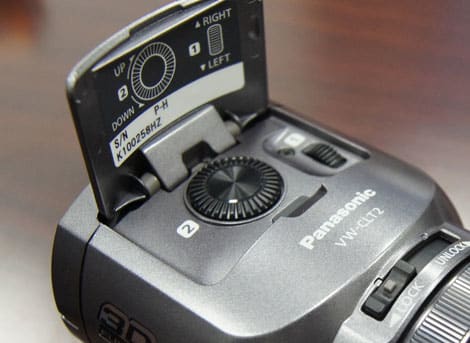
3D Controls
{{section_header}}{{section.name}}{{/section_header}}
5x optical zoom can be used during 3D recording on the GS-TD1, which is more than Panasonic can say with their HDC-SDT750 (no zoom with 3D recording). Additionally, JVC lets you take 3D photos and perform 3D time-lapse recording on the GS-TD1.
There is a parallax adjustment option on the GS-TD1, but we're not quite sure when or how you are supposed to use it. The dual lens system should be properly calibrated for 3D recording already, but the parallax adjustment may help for enhancing the 3D effect in specific situations. We did try it out on the TD1 and it appeared to do the same thing as the 3D calibration controls on the Panasonic HDC-SDT750. You can make the separation of the two images recorded by each lens larger, thereby altering the 3D performance in some manner.
{{product.manufacturer_specs['FI 3D Physical Controls Image']}}{{product.manufacturer_specs['FI 3D Physical Controls Image 2']}}
{{product.manufacturer_specs['FI 3D Controls Menu Image']}}
3D Playback
{{section_header}}{{section.name}}{{/section_header}}
Obviously, you can watch 3D videos recorded with the TD1 on a 3D television by connecting the camcorder to a TV via HDMI. But, you can also watch 3D video right on the camcorder itself with JVC's glasses-free 3D LCD. Honestly, the LCD looked very bad in our time with the camcorder, but we saw the same poor performance from Sony's glasses-free 3D LCD on the HDR-TD10.
{{product.manufacturer_specs['FI 3D Playback Menu Image']}}
Ease of Use
{{section_header}}{{section.name}}{{/section_header}}
The GS-TD1 appears more daunting than a regular camcorder due to its 3D capability. Its large design and dual lens system definitely doesn't shout "simplicity", but they camcorder isn't that difficult to handle overall. You can set all the controls to automatic in 3D or 2D mode, or you can choose to adjust controls manually. The main thing that makes the GS-TD1 more complicated is simply its bulky design. If you can get beyond this factor, the camcorder really isn't any more difficult than a traditional model.
Handling
{{section_header}}{{section.name}}{{/section_header}}
The GS-TD1 is certainly large, and its shape doesn't fit very well into your hand, but this seems to be what the industry has set forward for 3D camcorders. The JVC TD1 is similar in size and design to the Sony HDR-TD10, which also features dual lenses and dual sensors. Panasonic's 3D-capable camcorders use conversion lens attachments, so they aren't as bulky unless you're actually recording 3D (the conversion lenses must be removed for 2D recording).
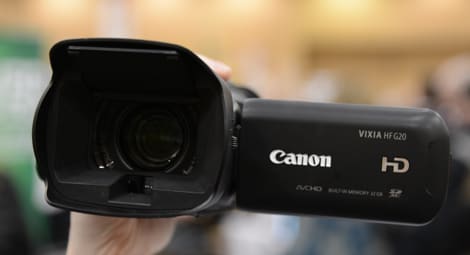
Unfortunately, the GS-TD1 feels a bit cheap and hollow compared to the Sony HDR-TD10. This hollow feel may be due to the fact that the camcorder is... well, hollow. The battery compartment is inside the camcorder's right side and it is essentially a huge gaping hole in the middle of the camcorder. When a battery is inserted the TD1 still feels hollow, but it does have a good balance. This is something that can definitely not be said about the Panasonic HDC-SDT750 when its 3D conversion lens is attached (it feels very top heavy up front).


Portability
{{section_header}}{{section.name}}{{/section_header}}
The GS-TD1 is a bulky camcorder, but it felt a bit lighter overall than the Sony HDR-TD10 (which also has two lenses). This lighter feel may have to do with the placement of the battery compartment in the middle of the camcorder. This placement is awkward for removing and inserting batteries, but it does give the TD1 more even balance. JVC has not released the exact weight and dimensions of the TD1 at this time, so we can't give you the full details, but it is clear by looking at the camcorder that it is a lot bigger than your average consumer model.
Battery
{{section_header}}{{section.name}}{{/section_header}}
As we said in the portability and handling sections above, the battery compartment for the GS-TD1 is oddly located. And it's not just an odd location either, the battery is difficult to access as well. To insert or remove the battery, you first must open a door on the right side of the camcorder. Then you must press a small battery release switch to remove the battery and fit your hands into the compartment to actually get at the battery. This is surprisingly awkward, particularly if you have large hands and fingers that don't fit into the compartment with ease. It's a strange design, but we do like the fact that JVC decided to put the compartment inside the GS-TD1 rather than making the camcorder even larger with a rear-mounted battery compartment.

LCD & Viewfinder
{{section_header}}{{section.name}}{{/section_header}}
The LCD on the GS-TD1 offers a glasses-free 3D display, but we were very disappointed with its quality. When in "3D" mode, the LCD looked blurred and scratchy—kind of like looking at a hologram or one of those funky 3D images that you occasionally see on cards or in a magazine. We didn't like the glasses-free 3D LCD on the Sony HDR-TD10 either, but, after looking at both the Sony and the JVC, we think Sony did the 3D LCD a bit better (if only by a hair).
When using the LCD in 2D mode, the screen looks fantastic. The fact that its 3.5-inch display is large and crystal clear in 2D mode only makes things seem even worse when you switch to 3D view. JVC also implemented a new touchscreen interface on this year's crop of HD camcorders (the GS-TD1 included). The touchscreen has its problems, as all touchscreens tend to, but the large screen area does make the interface easier to use than some.
Despite its large frame that could certainly accommodate one, the GS-TD1 does not contain a viewfinder.



Menus
Audio Features
{{section_header}}{{section.name}}{{/section_header}}
The GS-TD1 has a built-in microphone with what JVC calls "3D sound" using Biphonic technology. Whether these fancy terms actually result in better audio performance is an unknown at this point, but it is something we'll investigate when we get the TD1 into our labs. JVC does offer a few audio features, including wind cut and a limited audio level control adjustment, on the GS-TD1 as well.

Connectivity
Still Features
Other Features
{{section_header}}{{section.name}}{{/section_header}}
3D Time-Lapse recording
JVC has offered time-lapse recording on a number of models in the past, but the GS-TD1 has 3D time-lapse recording. Since both 3D and time-lapse recording are fairly gimmicky features, we think they may actually go together quite well. You can carefully set up your single shot and let it pan out over a long period of time—in 3D!
Conclusion
Like the Sony HDR-TD10, the GS-TD1 is a bulky camcorder that is roughly twice the size of your average consumer model. Because of its girth, we can't imagine why anyone would buy the TD1 unless they were absolutely serious about shooting most of their video footage in 3D. Our prediction is the TD1 will be an excellent 2D camcorder, but its $1999 price tag and large frame make it a bad choice for consumers who simply want to record regular 2D footage.
What impressed us about the GS-TD1 was the camcorder's extensive set of manual controls and features that were functional in both 2D and 3D record mode. This includes regular manual controls like shutter speed adjustment, as well as other features like 3D time-lapse recording and a 3D still image mode. These are things that set the TD1 apart from the other 3D camcorders currently available.
We're expecting the GS-TD1 to produce 3D video on par or better than the Sony HDR-TD10 due to the similarities in their dual sensor and lens design. Whichever camcorder does better in our testing will likely turn out to be the best 3D camcorder of 2011. For now, though, we remain a bit more excited about the JVC GS-TD1, mainly because it is the more versatile model in terms of controls and features. In our testing, we may find more faults with the TD1, however, so take this opinion lightly for now.
Photo Gallery
{{photo_gallery "FI Lens Image", "FI Front Image", "FI Right Image", "FI Back Image", "FI Left Image", "FI Left Open Image", "FI Top Image", "FI Bottom Image", "FI Media Image", "FI Easy Mode Image", "FI Zoom Image", "FI Zoom Image 2", "FI 3D Lens Image", "FI 3D Lens Image 2", "FI 3D Physical Controls", "FI 3D Physical Controls 2", "FI Handling Image", "FI Handling Image 2", "FI Handling Image 3", "FI Battery Image", "FI LCD Image", "FI Viewfinder Image", "FI Viewfinder Image 2", "FI Playback Image", "FI Mic Image", "FI Flash Image", "FI Photo Mode Image", "FI Ports Image 1", "FI Ports Image 2", "FI Ports Image 3", "FI Ports Image 4", "FI Ports Image 5", "FI Ports Image 6"}}
Specs
{{manufacturer_specs_table}}
Meet the tester
Jeremy is the video expert of our imaging team and Reviewed.com's head of video production. Originally from Pennsylvania and upstate NY, he graduated from Bard college with a degree in film and electronic media. He has been living and working in New England since 2005.
Checking our work.
Our team is here for one purpose: to help you buy the best stuff and love what you own. Our writers, editors, and lab technicians obsess over the products we cover to make sure you're confident and satisfied. Have a different opinion about something we recommend? Email us and we'll compare notes.
Shoot us an email


